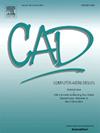矩阵表示和gpu优化的并行b样条计算
IF 3.1
3区 计算机科学
Q2 COMPUTER SCIENCE, SOFTWARE ENGINEERING
引用次数: 0
摘要
b样条建模是CAD系统的基础,目前使用的评估和操作算法是几十年前开发的,特别是针对CPU架构。虽然这些算法在许多应用中仍然有效,但随着CAD模型变得越来越复杂,例如大规模装配和微结构,这些算法变得越来越不合适。GPU加速提供了一个很有前途的解决方案,但大多数现有的GPU b样条算法只是简单地适应CPU对应,而没有考虑到b样条的非结构化、递归性质和GPU内核的结构化性质之间的不匹配,最终未能充分利用GPU的能力。本文提出了一种将b样条表示转换为规则矩阵结构的新方法,将所有的求值和操作计算减少到矩阵的加法和乘法,从而更好地适应GPU架构。通过将这种矩阵表示与gpu优化的任务调度和内存访问模式相结合,本文证明了在关键的b样条运算的反演和投影方面有显着的性能改进。实验结果表明,与现有方法相比,该方法的计算速度提高了约两个数量级。本文章由计算机程序翻译,如有差异,请以英文原文为准。
Matrix representation and GPU-optimized parallel B-spline computing
B-spline modeling is fundamental to CAD systems, and its evaluation and manipulation algorithms currently in use were developed decades ago, specifically for CPU architectures. While remaining effective for many applications, these algorithms become increasingly inadequate as CAD models grow more complex, such as large-scale assemblies and microstructures. GPU acceleration offers a promising solution, but most existing GPU B-spline algorithms simply adapt CPU counterparts without accounting for the mismatch between the unstructured, recursive nature of B-splines and the structured nature of GPU kernels, ultimately failing to fully leverage GPU capabilities. This paper presents a novel approach that transforms B-spline representations into regular matrix structures, reducing all evaluation and manipulation computations to matrix addition and multiplication, thus better aligning with GPU architecture. By combining this matrix representation with GPU-optimized task scheduling and memory access patterns, the paper demonstrates significant performance improvements in the key B-spline operations of inversion and projection. Experimental results show an improvement of about two orders of magnitude in computational speed compared to existing methods.
求助全文
通过发布文献求助,成功后即可免费获取论文全文。
去求助
来源期刊

Computer-Aided Design
工程技术-计算机:软件工程
CiteScore
5.50
自引率
4.70%
发文量
117
审稿时长
4.2 months
期刊介绍:
Computer-Aided Design is a leading international journal that provides academia and industry with key papers on research and developments in the application of computers to design.
Computer-Aided Design invites papers reporting new research, as well as novel or particularly significant applications, within a wide range of topics, spanning all stages of design process from concept creation to manufacture and beyond.
 求助内容:
求助内容: 应助结果提醒方式:
应助结果提醒方式:


